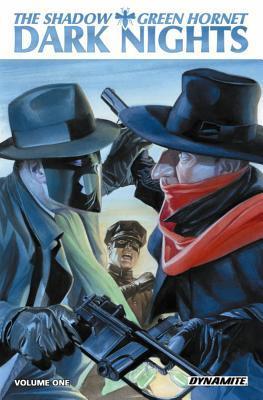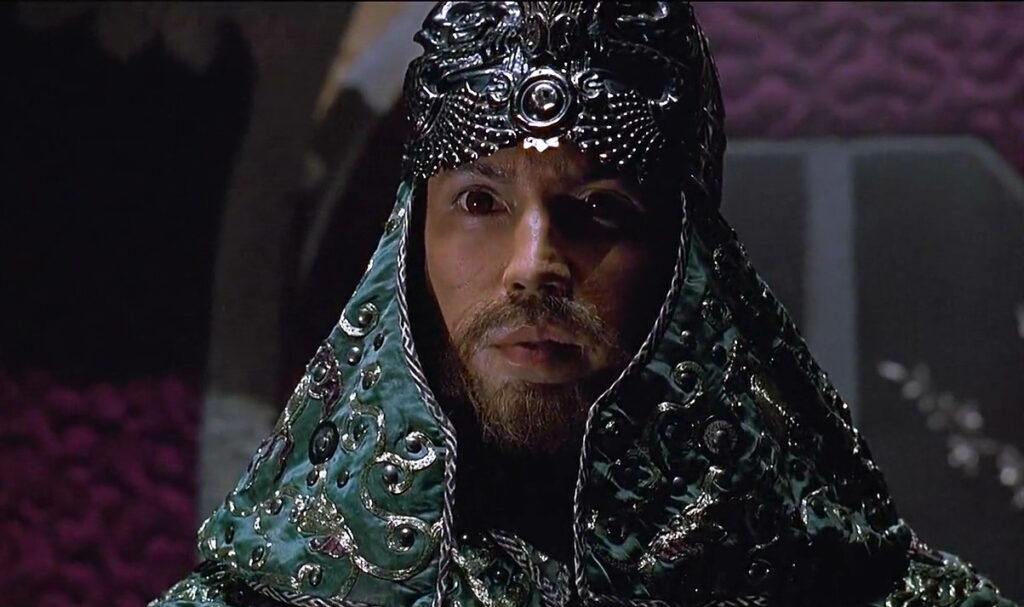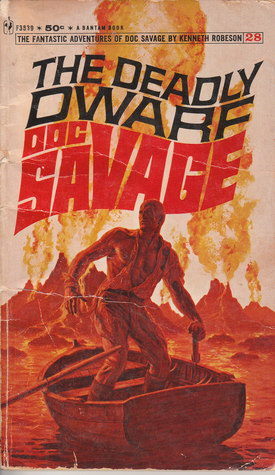Based on Greg Hatcher’s recommendation I read Shadow/Green Hornet: Dark Nights by Michael Uslan and Keith Burns last year and I enjoyed it.
The Shadow’s old foe Shiwan Khan, having launched WW II just as he brought about the First World War, now targets America with a scheme to disable its industries and to obtain the Shadow’s fire opal ring for its secret mystical power. He knows he’ll have to deal with the Shadow but assumes the Green Hornet — who poses as an underworld figure eliminating his rivals — will be a convenient ally. Oops … It’s a lot of fun but I could have done without Shiwan Khan as the villain of the piece. Shiwan Khan, for any non-Shadow fans, was a descendant of Genghis Khan, dedicated to conquering the world as his ancestor did. Descendants of Genghis Khan are always showing up in adventure fiction to conquer the world, probably because they combine the “sinister oriental” stereotype with the image of Genghis Khan and his unstoppable Mongol hordes. Shiwan Khan stands out because Shadow-scribe Walter Gibson is good enough to make him memorable (though still a stereotype) and because he battled the Shadow four times, a record for the Shadow’s rogue’s gallery.
Shiwan Khan, for any non-Shadow fans, was a descendant of Genghis Khan, dedicated to conquering the world as his ancestor did. Descendants of Genghis Khan are always showing up in adventure fiction to conquer the world, probably because they combine the “sinister oriental” stereotype with the image of Genghis Khan and his unstoppable Mongol hordes. Shiwan Khan stands out because Shadow-scribe Walter Gibson is good enough to make him memorable (though still a stereotype) and because he battled the Shadow four times, a record for the Shadow’s rogue’s gallery.
Precisely because he’s such a prominent Shadow adversary, everyone uses him. And then uses him some more. The 1994 Shadow movie with John Lone (which I liked a lot) —
The infamously awful Archie Comics Shadow—
DC’s Bronze Age book, #11 (also by Uslan) — And DC’s later The Shadow Strikes.
And DC’s later The Shadow Strikes.
This would be over-use even if Shiwan Khan wasn’t a stereotype (and a completely villainous one, without any of the anti-hero aspects of Fu Manchu). It’s not like he’s the only super-criminal the Master of Darkness fought. Dr. Roderick Moquino, the Voodoo Master, battled the Shadow three times; the Wasp battled him twice. Even a one-shot villain could work: the Shadow smashed the conspiracy of the Silent Seven over two books — — but a conspiracy can always reform, Hydra-style.
— but a conspiracy can always reform, Hydra-style.
Doc Savage comic books do the same thing with John Sunlight. The creepy, controlling schemer first appears in Fortress of Solitude —  — then returns in the underwhelming Devil Genghis. He’s the only Doc Savage foe to go two rounds with the Man of Bronze and he’s chilling as hell (in the first book; the second, not so much), way more impressive than Shiwan Khan. Even so, I could do without him turning up over and over in comics; the author of 2017’s Doc Savage:Ring of Fire jokes about it, but still uses him.
— then returns in the underwhelming Devil Genghis. He’s the only Doc Savage foe to go two rounds with the Man of Bronze and he’s chilling as hell (in the first book; the second, not so much), way more impressive than Shiwan Khan. Even so, I could do without him turning up over and over in comics; the author of 2017’s Doc Savage:Ring of Fire jokes about it, but still uses him.
 It’s true that Doc has fewer foes worthy of a rematch but he does have some. Cadwiller Olden, the dwarf crimelord and scientific genius in Repel (AKA The Deadly Dwarf in paperback) seems to have escaped at the end of the novel. He’s formidable enough to deserve a return appearance but I’m not aware he’s ever received one.
It’s true that Doc has fewer foes worthy of a rematch but he does have some. Cadwiller Olden, the dwarf crimelord and scientific genius in Repel (AKA The Deadly Dwarf in paperback) seems to have escaped at the end of the novel. He’s formidable enough to deserve a return appearance but I’m not aware he’s ever received one.
The overuse of foes such as Khan and Sunlight may reflect that (as I’ve discussed on my own blog) modern writers seem to crave an archenemy for their characters more than the pulp authors did. In Robert E. Howard’s Conan stories, the Stygian sorcerer Thoth-Amon barely knew Conan existed; the Lancer Conan pastiches made them into nemeses and he plays a larger role in comics too. Perhaps it’s not surprising that Shiwan Khan, who appeared in a mere four of more than 300 Shadow pulps, gets similarly amped up.
Not surprising, but I’m not so sure it’s a good thing either.
#SFWApro. Covers top to bottom by Keith Burns, Paul Reinman, Michael Kaluta, Eduardo Barreto, James Steranko and two by James Bama.


Now I’m looking for Grace Jones in A View To A Kill.
Or… hear me out… they could create their own villains?
I think the problem, though, is part of a broader problem Peter David mentioned when adapting The Dark Tower for comics:
Apparently, people kept complaining that ‘that doesn’t sound like the original voice of the books’ – but everything they complained about was from the original books, and the stuff they left alone was Peter David’s own work.
So, basically, the original author can do what they want with their own work; but a new author (adapter, continuer, whateverer) has to make it sound like the original. So any villain they invent is going to be scrutinised for ‘that’s not like the original!’
Combine that with ‘this is work for hire, you don’t keep the rights on your own creation’ and I think I’ve just countered my own point.
Yes, as a friend of mine put it it’s harder to argue an Agatha Christie story isn’t true to Agatha Christie’s work.